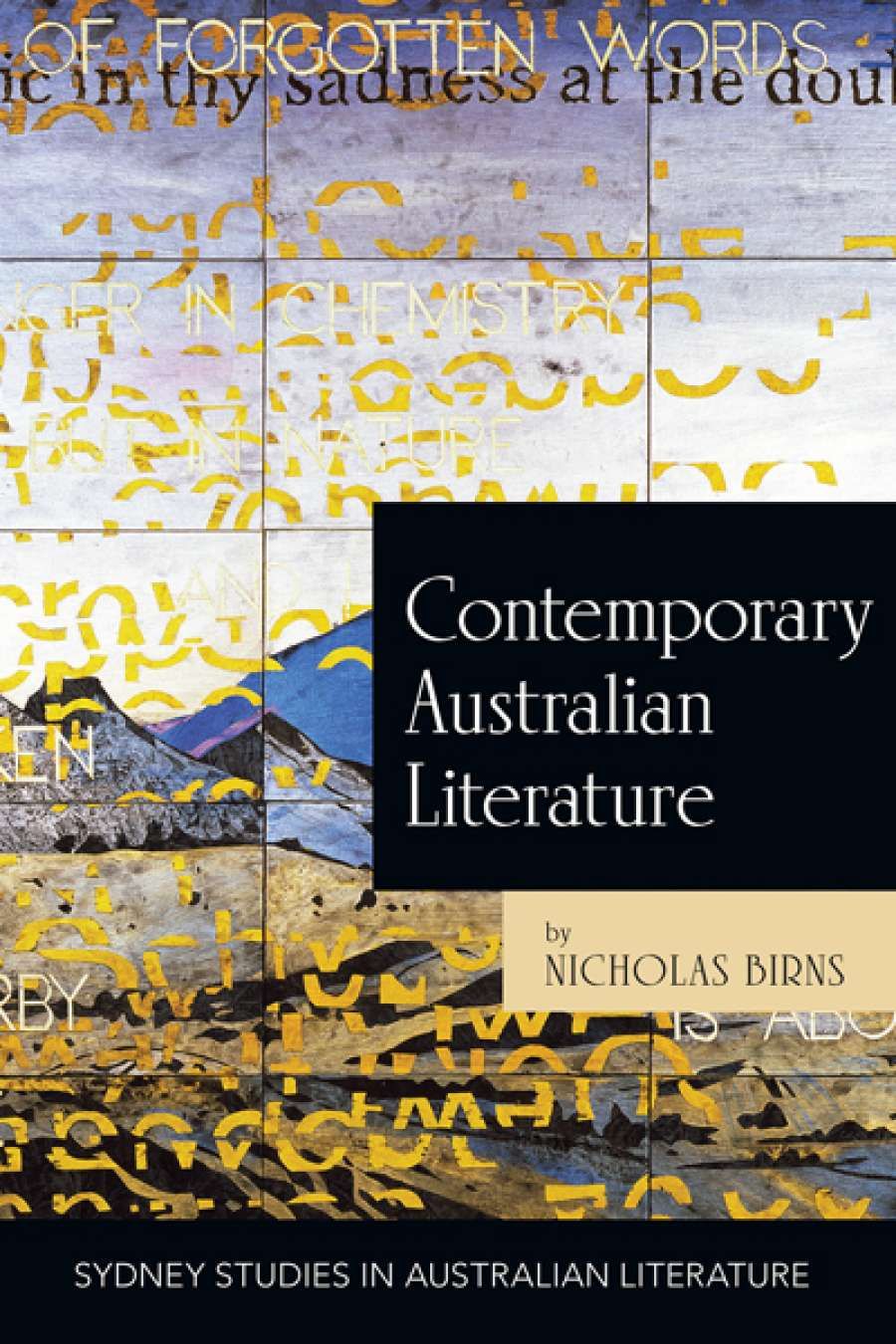
- Free Article: No
- Contents Category: Literary Studies
- Custom Article Title: Susan Lever reviews 'Contemporary Australian Literature' by Nicholas Birns
- Book 1 Title: Contemporary Australian Literature
- Book 1 Subtitle: A World Not Yet Dead
- Book 1 Biblio: Sydney University Press, $30 pb, 280 pp, 9781743324363
Birns is not offering us a canon of aesthetic or social value. He rightly states that Australian literature has never established a set canon; it is a literature of pluralities. He also acknowledges that no one reader can possibly claim to have read across the entire Australian publishing output of the past thirty years, so that authoritative statements of literary value are impossible. He chooses to discuss the novels and poems that interest him, though his reading is so wide that few local scholars could match it. His guide to selection is a rather generalised notion of resistance to threats to the imagination, in particular the way recent Australian fiction treats the division between 'social winners and losers', a criterion that becomes generously inclusive.
He begins with mid-century modernity, discussing Christina Stead's The Man Who Loved Children (1940), For Love Alone (1944), and Letty Fox: Her Luck (1946) as Australian novels, insisting that 'Letty Fox evokes a hidden Australian identity from within the transnational maw of New York'. He traces the shift from modernity to late modernity in the work of Elizabeth Harrower and Patrick White, considering the recent publication of Harrower's In Certain Circles (2014) and White's The Hanging Garden (2012) as commentaries on the neo-liberal commitment to individual success. He is content to support his broad generalisations with an eclectic range of references; Zadie Smith's 2014 speech at Birns's campus, the New School in New York, offers 'proof that what I am calling neoliberalism was all-pervasive and was not just a function of a particular party platform or administrative practice'. To question these kinds of 'proofs' is to make reading this book impossible. They are part of a miscellany of ideas that keep Birns surging forward to engage with the Australian writing he likes.
In a chapter on the reception of Australian novels, Birns argues that the short novel (which he calls the récit) fell out of fashion with the arrival in the 1980s of the big postmodernist novels (Rushdie, Pynchon, Márquez) that offered synecdochic versions of whole nations. Using reviews of Australian fiction in the New York Times Review of Books and nominations for the Booker Prize as a basis, he surveys responses to Australian work, noting the American and British preference for novels that claim to canvass the Australian nation. He suggests this valuing by length is a sign of neoliberalism's mechanistic measuring of success and applauds the recent critical successes of Tim Winton's Eyrie (2014) and Richard Flanagan's The Narrow Road to the Deep North (2014) as a sign of the resurgence of the récit.
 Letty Fox: Her Luck by Christina Stead (first edition, Harcourt, Brace, & Company, 1946)
Letty Fox: Her Luck by Christina Stead (first edition, Harcourt, Brace, & Company, 1946)
How does literature resist the dominant neo-liberal ideology? Birns finds this resistance in the 'affective' responses of literature, 'feeling takes up ... the ethical burden previously borne by more direct modes of social comment'. This leads him to trace the emotion of rancour, expressed in the work of A.D. Hope, Christos Tsiolkas, Ouyang Yu, John Kinsella, J.M. Coetzee, Pam Brown, and Jennifer Maiden. He addresses questions about the land and displacement of indigenous peoples by ranging across the writing of Thomas Keneally, Arthur Upfield, Kate Grenville, Gail Jones, Alex Miller, by contrast with indigenous writing and the novels of Alexis Wright (he likens the difference between the work of earlier indigenous writers and Wright to the differences in early and late Dickens). The recent work of Frank Moorhouse, Gerald Murnane, and Brian Castro provides evidence of the international idealism of Australian writing, while Peter Carey's fiction gets a whole chapter examining his transnational challenge to prevailing neo-liberal values. In a typically quirky digression, Birns considers two actual people – the late enthusiast for nineteenth-century Australian literature Victor Crittenden, and former NSW Premier Bob Carr on the basis of his Diary of a Foreign Minister (2014) – in terms of Carey's fictional characters. The book ends with an examination of Hannah Kent's Burial Rites (2013) and Eleanor Catton's The Luminaries (2014), Catton's New Zealand residence and nationality being swept aside on the grounds of cultural similarities between Australia and New Zealand and because Catton 'has lashed out against the cruel inequalities of neoliberalism in a way no Australian writer has'.
Contemporary Australian Literature is a book of wide-ranging ideas and surprising conjunctions. It does not claim to offer authoritative readings, but its insistence that literature has a direct relationship to prevailing economic doctrine should stimulate new discussions among Australian readers. I wonder whether any Australian critic will take up the assertion in this book, and in Giles's, that Australian critics have been blinkered by literary patriotism in their responses to Peter Carey. In Birns we have a reader with few evident prejudices, ready to tackle everyone from A.D. Hope to Colleen McCullough.


Comments powered by CComment